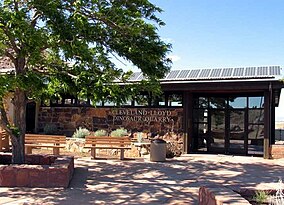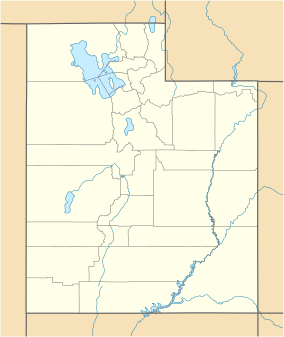Cleveland-Lloyd Dinosaur Quarry
| Cleveland-Lloyd Dinosaur Quarry | |
|---|---|

Cleveland-Lloyd Dinosaur Quarry Visitor Center
|
|
| Map of Utah | |
| Location | Emery County, Utah |
| Nearest city | Cleveland |
| Coordinates | 39°19′22″N 110°41′22″W / 39.32282°N 110.68951°WCoordinates: 39°19′22″N 110°41′22″W / 39.32282°N 110.68951°W |
| Governing body | Bureau of Land Management |
| https://www.blm.gov/wo/st/en/res/Education_in_BLM/Learning_Landscapes/For_Travelers/go/geology/cleveland-lloyd.html | |
| Designated | 1965 |
The Cleveland-Lloyd Dinosaur Quarry, located in the San Rafael Swell, near Cleveland, Utah, contains the densest concentration of Jurassic dinosaur fossils ever found. Well over 15,000 bones have been excavated from this Jurassic "predator trap" and there are many thousands more awaiting excavation and study. It was designated a National Natural Landmark in October 1965.
The visitor center is administered by the Bureau of Land Management. There is a skeleton reconstruction of an adult Allosaurus (and other bones) on display in the visitor center, along with many other exhibits. A renovated and expanded quarry visitor center was dedicated on April 28, 2007. The visitor center is open seasonally with variable hours.
The quarry was found by sheepmen and cowmen as they drove their animals through the area during the late 19th century. In 1927, the Department of Geology at the University of Utah, under the direction of Chairman F.F. Hintze, visited the area and collected 800 bones. In 1939, a field party from Princeton University led by William Lee Stokes began work. In three summers, they collected 1,200 bones. The quarry was not worked again until 1960. In 1974, a new dinosaur was described by James H. Madsen, Jr., Assistant Research Professor of Geology and Geophysics, University of Utah. He named it Stokesosaurus clevelandi. In 1976, another new dinosaur was described from fossils found in the quarry by Madsen. He named it Marshosaurus bicentesimus. In 1987, Brigham Young University paleontologists excavated a fossil dinosaur egg, at the time the oldest such egg ever found.
Over the years, excavations led by the University of Utah and the Utah Museum of Natural History have resulted in the collection of more than 12,000 fossil bones from the quarry. While most of the original fossils are currently housed at the Utah Museum of Natural History, many skeletons reproduced from Cleveland-Lloyd dinosaur remains are now on exhibit in more than 65 museums worldwide. Original specimens from the quarry remain on public exhibit in Utah at the Utah Museum of Natural History in Salt Lake City, the Utah State University Eastern Prehistoric Museum in Price and the Earth Science Museum at Brigham Young University in Provo.
...
Wikipedia

